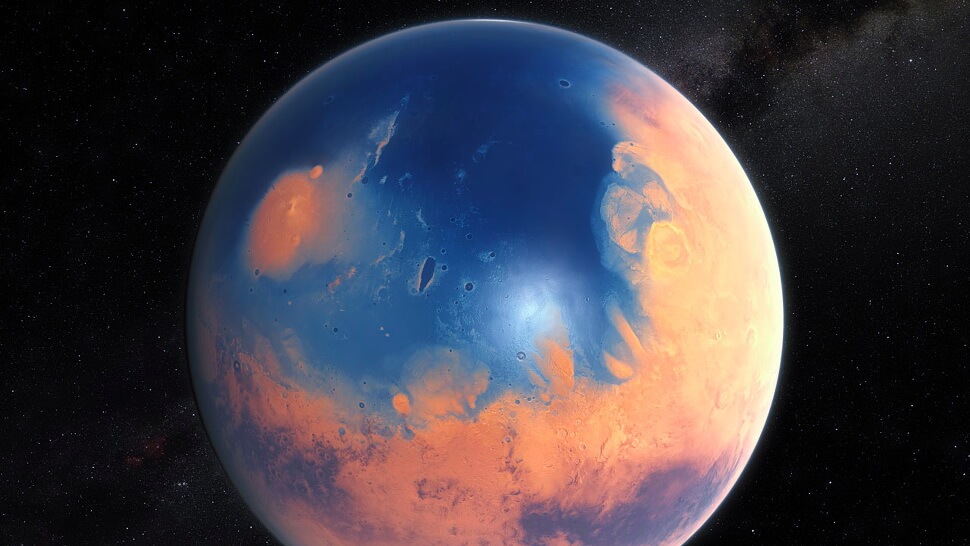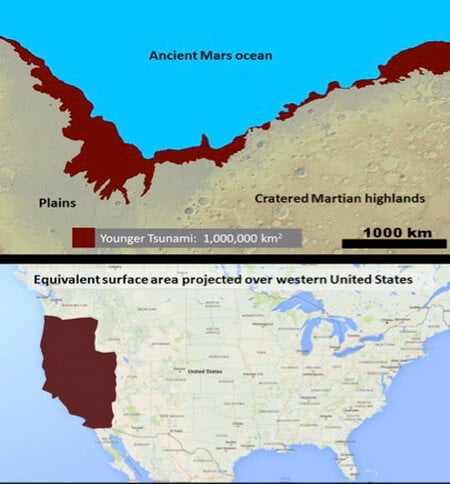- Get link
- X
- Other Apps

In the northern hemisphere of Mars once there was a huge ocean. New observations and findings of scientists speak in favor of the fact that at least two megatsuns occurred on the Martian surface, caused by meteorite falls. Traces of these catastrophic events can still be seen on the Martian surface, and, moreover, they may still contain traces of ancient Martian life.
Of course, it is difficult to immediately believe that once on a lifeless and deserted planet like Mars, rivers once flowed and raged powerful tsunamis, but it is quite possible that this was all true. About 3.4 billion years ago, the underground waters of the planet burst to the surface and formed a cold and salty ocean in the northern lowland hemisphere. In some regions, its depth reached almost 2 kilometers. It is possible that microbial life existed in this environment. Over time, the planet's climate has changed significantly and almost all the water has evaporated.
So the theory goes. And its main idea is primarily based on assumptions about how much water there was once on Mars and where exactly this water was on its surface. However, scientists have not only guesses, but some very real data. Taking into account the lack of clear outlines of coastlines, scientists can not yet say with certainty that once the northern hemisphere of the Red Planet was indeed covered with water. However, new data provided by researchers from the US Planetological Institute, offer to look at the most convincing evidence to date in favor of this opinion. The data suggests that there was not only an ocean there - this ocean witnessed at least two most powerful megatsuns.

Left: a color digital model of the elevations of the relief of the studied area offers two versions of the marine lines of the early Martian ocean, which existed on the planet about 3.4 billion years ago. Right: Tsunami areas near these shipping lines
J. Alex P. Rodriguez of the United States Institute of Planetology and his colleagues at Cornell University recently completed a detailed analysis of the surface of the plains of the northern hemisphere of Mars. As part of this analysis, traces of the once ancient ocean were found. True, not exactly where expected. The geological peculiarity of the ancient Martian sea lines and their internal forms suggests that two large meteorites fell in these areas (several million years in between) and caused massive megatsuns. Raised huge waves, going deeper by several hundred kilometers of land, changed the Martian landscape and left marks that can be seen even now.

This dark region with a length of 250 kilometers can be followed by Martian mega-tsunami. The temperature on Mars at that time was so low that the water quickly turned into ice porridge
Two fallen meteorites created craters with a diameter of about 30 kilometers and caused a tsunami, whose waves reached 120 meters in height. For comparison: the height of the waves of the most powerful tsunami that hit Japan in 2011 reached 39 meters.

The white arrows indicate the highest points of the surface where the first tsunami reached.
After hitting the first tsunami, channels formed on the surface, through which water returned to the ocean. These relief formations are still preserved, and they can be observed in the form of residual deposits. The second tsunami occurred several million years later (according to scientists, large meteorites hit Mars every 3 million years). By this time, the Martian history of the planet's climate has become significantly colder. The water turned to ice, and the original coastline receded inside. The second megatsunami left behind a variety of physical evidence, including ice caps on the hollows.
“These caps are frozen on land, reaching hollows. And the water never returned to the ocean, although it is assumed that the ocean was partially, but still remained unfrozen, ”says research co-author and employee of Cornell University Alberto Fayren.
"Our work provides compelling evidence of the existence of very cold oceans in the early history of Mars."

This map shows the scale and level of the first tsunami compared to the west coast of the United States.
As the tsunami retreated, the water began to turn into ice, but once in the hollows, it remained there. All indications are that this water was rich in salts, which is excellent news. Salt allows you to keep the water liquid form, which, in turn, is very important for the emergence of life.
“If there was life on Mars, then these ice caps left by the tsunami are great places to search for biosignatures,” says Fayren.
“The presence of salt in the composition of the water could allow the Martian oceans to remain in the liquid state for up to ten million years. The astrobiological consequences of this can be incredible, ”adds Rodriguez.
For further study of this idea and as possible tasks for future Martian missions, scientists identified regions that were most heavily flooded by the Martian tsunami. These areas include areas with displaced residual water, as well as with salt and mineral sediments. For future missions using rovers or manned missions, an excellent target for research.
The article is based on materials .
- Get link
- X
- Other Apps
Comments
Post a Comment